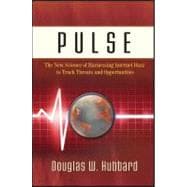
| Preface | p. xi |
| Acknowledgments | p. xiii |
| Introduction to the Pulse: A New Kind of Instrument | |
| A New Era for Measuring and Predicting Society | p. 3 |
| An Emerging Science: What Is This New Thing? | p. 6 |
| What The Pulse Isn't | p. 8 |
| The Major Areas of the Macro-Pulse | p. 12 |
| What Does All of This Mean for Us? | p. 14 |
| Notes | p. 15 |
| The History of Seeing the Forest through the Trees | p. 17 |
| The King's Surveys | p. 18 |
| The Dawn of Stats, Theme-Maps, and Telegraphs | p. 20 |
| The Rise of the Machines | p. 25 |
| The Struggle to Become a Science | p. 28 |
| Notes | p. 31 |
| Emergence of the Pulse and the New Research Discipline | p. 33 |
| Ubiquitous Use of the Internet | p. 34 |
| Digital Lives: Increasing Time and Activities per Person | p. 39 |
| Open Pastures: A New Field of Research | p. 45 |
| Proving the Pulse: Addressing Misconceptions about the Data | p. 47 |
| Notes | p. 52 |
| Dynamics of the Pulse | p. 53 |
| Incentives: Why the Pulse Exists | p. 53 |
| The Systems behind Getting and Sharing Data | p. 55 |
| Collaboration and Competition | p. 58 |
| Power Law: Why a Few Sources Tell Us a Lot on the Internet | p. 59 |
| Notes | p. 63 |
| Sources of the Pulse | |
| What Our Surfing Says | p. 67 |
| Tracking Flu Outbreaks: A Faster, Better, and Cheaper Method | p. 68 |
| A Do-It-Yourself Pulse Tracking Example: Using Google Trends for Economic Predictions | p. 73 |
| More Searchology: The Body of Research Grows | p. 81 |
| Caveats and Miscellaneous Considerations for Searchologists | p. 84 |
| Notes | p. 87 |
| ôFriendö as a Verb | p. 89 |
| How Do Social Networks Matter? | p. 90 |
| The Dynamic Duo of Social Connections: Two Leaders in Practical Network Research | p. 92 |
| Forecasting the Crowd | p. 97 |
| Social Networks in the Pulse | p. 98 |
| Notes | p. 104 |
| What We Say Online Matters | p. 107 |
| An Introduction to Analyzing Buzz: Counting Tweets Predicts Movie Box Office Receipts | p. 108 |
| Predicting the Broader Economy with Tweets | p. 112 |
| Predicting Markets with Anxiety | p. 117 |
| Tools and Miscellanea for Tapping into the Global Mood | p. 119 |
| Notes | p. 123 |
| Three Potential Pulses: Where We Go, What We Buy, and How We Play | p. 125 |
| Our Flow and the Pulse: What the Movements of Millions of People Tell Us | p. 126 |
| The Shopping Pulse | p. 131 |
| Playtime and the Pulse | p. 136 |
| Notes | p. 140 |
| Effects of the Pulse | |
| Making the Pulse Practical | p. 143 |
| Rethinking Real-Time Decisions in the Pulse | p. 144 |
| A Brief Overview of the Economics of Timely Information | p. 149 |
| Overcoming Cultural and Conceptual Obstacles: Maximizing the Value of the Pulse | p. 154 |
| Implementing the Pulse | p. 156 |
| Notes | p. 159 |
| The Future of the Pulse and Its New Challenges | p. 161 |
| Users and the Data They Share Will Increase | p. 162 |
| Services Will Be Better and Make More Data Public | p. 165 |
| Research and Models | p. 169 |
| From Communicators to Tricorders-for Everyone | p. 171 |
| Evolving Opportunities and Challenges for Users of the Pulse | p. 173 |
| Notes | p. 177 |
| About the Author | p. 179 |
| Index | p. 181 |
| Table of Contents provided by Ingram. All Rights Reserved. |
The New copy of this book will include any supplemental materials advertised. Please check the title of the book to determine if it should include any access cards, study guides, lab manuals, CDs, etc.
The Used, Rental and eBook copies of this book are not guaranteed to include any supplemental materials. Typically, only the book itself is included. This is true even if the title states it includes any access cards, study guides, lab manuals, CDs, etc.